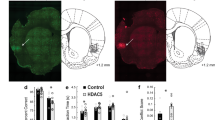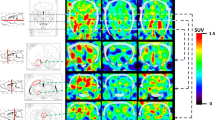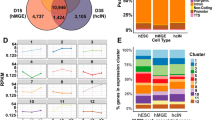Abstract
Neuronal outgrowth is guided by both extrinsic and intrinsic factors, involving transcriptional regulation. The acetylation of histones and transcription factors, which facilitates promoter accessibility, ultimately promotes transcription, and depends on the balance between histone deacetylases (HDACs) and histone acetyltransferases (HATs) activities. However, a critical function for specific acetylation modifying enzymes in neuronal outgrowth has yet to be investigated. To address this issue, we have used an epigenetic approach to facilitate gene expression in neurons, by using specific HDAC inhibitors. Neurons treated with a combination of HDAC and transcription inhibitors display an acetylation and transcription-dependent increase in outgrowth and a reduction in growth cone collapse on both ‘permissive’ (poly-D-lysine, PDL) and ‘non-permissive’ substrates (myelin and chondroitin sulphate proteoglycans (CSPGs)). Next, we specifically show that the expression of the histone acetyltransferases CBP/p300 and P/CAF is repressed in neurons by inhibitory substrates, whereas it is triggered by HDAC inhibition on both permissive and inhibitory conditions. Gene silencing and gain of function experiments show that CBP/p300 and P/CAF are key players in neuronal outgrowth, acetylate histone H3 at K9-14 and the transcription factor p53, thereby initiating a pro-neuronal outgrowth transcriptional program. These findings contribute to the growing understanding of transcriptional regulation in neuronal outgrowth and may lay the molecular groundwork for the promotion of axonal regeneration after injury.
Similar content being viewed by others
Log in or create a free account to read this content
Gain free access to this article, as well as selected content from this journal and more on nature.com
or
Abbreviations
- CGN:
-
cerebellum granular neuron
- CBP:
-
CREB-binding protein
- CSPG:
-
chondroitin sulphate proteoglycan
- GAP-43:
-
growth-associated protein-43
- HAT:
-
histone acetyltransferase
- HDAC:
-
histone deacetylase
- PB:
-
sodium phenyl butyrate
- P/CAF:
-
p300/CBP-associated factor
- PDL:
-
poly-D-lysine
- RCN:
-
rat cortical neuron
- SAHA:
-
suberoylanilide hydroxamic acid
- TSA:
-
trichostatin A
References
Teng FY, Tang BL . Axonal regeneration in adult CNS neurons – signaling molecules and pathways. J Neurochem 2006; 96: 1501–1508.
Makwana M, Raivich G . Molecular mechanisms in successful peripheral regeneration. FEBS J 2005; 272: 2628–2638.
Mellor J . The dynamics of chromatin remodeling at promoters. Mol Cell 2005; 19: 147–157.
Reik W . Stability and flexibility of epigenetic gene regulation in mammalian development. Nature 2007; 447: 425–432.
Guan JS, Haggarty SJ, Giacometti E, Dannenberg JH, Joseph N, Gao J et al. HDAC2 negatively regulates memory formation and synaptic plasticity. Nature 2009; 459: 55–60.
Thiagalingam S, Cheng KH, Lee HJ, Mineva N, Thiagalingam A, Ponte JF . Histone deacetylases: unique players in shaping the epigenetic histone code. Ann NY Acad Sci 2003; 983: 84–100.
Yang XJ, Seto E . HATs and HDACs: from structure, function and regulation to novel strategies for therapy and prevention. Oncogene 2007; 26: 5310–5318.
Struhl K . Histone acetylation and transcriptional regulatory mechanisms. Genes Dev 1998; 12: 599–606.
Wolffe AP, Guschin D . Review: chromatin structural features and targets that regulate transcription. J Struct Biol 2000; 129: 102–122.
Saha RN, Pahan K . HATs and HDACs in neurodegeneration: a tale of disconcerted acetylation homeostasis. Cell Death Differ 2006; 13: 539–550.
Schwechter BR, Millet LE, Levin LA . Histone deacetylase inhibition-mediated differentiation of RGC-5 cells and interaction with survival. Invest Ophthalmol Vis Sci 2007; 48: 2845–2857.
Siebzehnrubl FA, Buslei R, Eyupoglu IY, Seufert S, Hahnen E, Blumcke I . Histone deacetylase inhibitors increase neuronal differentiation in adult forebrain precursor cells. Exp Brain Res 2007; 176: 672–678.
Balasubramaniyan V, Boddeke E, Bakels R, Kust B, Kooistra S, Veneman A et al. Effects of histone deacetylation inhibition on neuronal differentiation of embryonic mouse neural stem cells. Neuroscience 2006; 143: 939–951.
Jiang H, Poirier MA, Liang Y, Pei Z, Weiskittel CE, Smith WW et al. Depletion of CBP is directly linked with cellular toxicity caused by mutant huntingtin. Neurobiol Dis 2006; 23: 543–551.
Arany Z, Huang LE, Eckner R, Bhattacharya S, Jiang C, Goldberg MA et al. An essential role for p300/CBP in the cellular response to hypoxia. Proc Natl Acad Sci U S A 1996; 93: 12969–12973.
Rouaux C, Jokic N, Mbebi C, Boutillier S, Loeffler JP, Boutillier AL . Critical loss of CBP/p300 histone acetylase activity by caspase-6 during neurodegeneration. EMBO J 2003; 22: 6537–6549.
Glozak MA, Sengupta N, Zhang X, Seto E . Acetylation and deacetylation of non-histone proteins. Gene 2005; 363: 15–23.
Di Giovanni S, Knights CD, Rao M, Yakovlev A, Beers J, Catania J et al. The tumor suppressor protein p53 is required for neurite outgrowth and axon regeneration. EMBO J 2006; 25: 4084–4096.
Tedeschi A, Nguyen T, Puttagunta R, Gaub P, Di Giovanni S . A p53-CBP/p300 transcription module is required for GAP-43 expression, axon outgrowth, and regeneration. Cell Death Differ 2009; 16: 543–554.
Yoshida M, Kijima M, Akita M, Beppu T . Potent and specific inhibition of mammalian histone deacetylase both in vivo and in vitro by trichostatin A. J Biol Chem 1990; 265: 17174–17179.
Blagosklonny MV . Flavopiridol, an inhibitor of transcription: implications, problems and solutions. Cell Cycle (Georgetown, Tex) 2004; 3: 1537–1542.
Filbin MT . Myelin-associated inhibitors of axonal regeneration in the adult mammalian CNS. Nat Rev Neurosci 2003; 4: 703–713.
Allis CD, Berger SL, Cote J, Dent S, Jenuwien T, Kouzarides T et al. New nomenclature for chromatin-modifying enzymes. Cell 2007; 131: 633–636.
Nott A, Watson PM, Robinson JD, Crepaldi L, Riccio A . S-nitrosylation of histone deacetylase 2 induces chromatin remodelling in neurons. Nature 2008; 455: 411–415.
Knights CD, Catania J, Di Giovanni S, Muratoglu S, Perez R, Swartzbeck A et al. Distinct p53 acetylation cassettes differentially influence gene-expression patterns and cell fate. J Cell Biol 2006; 173: 533–544.
Freeland K, Boxer LM, Latchman DS . The cyclic AMP response element in the Bcl-2 promoter confers inducibility by hypoxia in neuronal cells. Brain Res 2001; 92: 98–106.
Gao Y, Deng K, Hou J, Bryson JB, Barco A, Nikulina E et al. Activated CREB is sufficient to overcome inhibitors in myelin and promote spinal axon regeneration in vivo. Neuron 2004; 44: 609–621.
Jung M, Petrausch B, Stuermer CA . Axon-regenerating retinal ganglion cells in adult rats synthesize the cell adhesion molecule L1 but not TAG-1 or SC-1. Mol Cell Neurosci 1997; 9: 116–131.
Aigner L, Arber S, Kapfhammer JP, Laux T, Schneider C, Botteri F et al. Overexpression of the neural growth-associated protein GAP-43 induces nerve sprouting in the adult nervous system of transgenic mice. Cell 1995; 83: 269–278.
Aigner L, Caroni P . Depletion of 43-kD growth-associated protein in primary sensory neurons leads to diminished formation and spreading of growth cones. J Cell Biol 1993; 123: 417–429.
Benowitz LI, Perrone-Bizzozero NI, Neve RL, Rodriguez W . GAP-43 as a marker for structural plasticity in the mature CNS. Prog Brain Res 1990; 86: 309–320.
Gianola S, Rossi F . GAP-43 overexpression in adult mouse Purkinje cells overrides myelin-derived inhibition of neurite growth. Eur J Neurosci 2004; 19: 819–830.
Di Giovanni S, De Biase A, Yakovlev A, Finn T, Beers J, Hoffman EP et al. In vivo and in vitro characterization of novel neuronal plasticity factors identified following spinal cord injury. J Biol Chem 2005; 280: 2084–2091.
Cai L, Marshall TW, Uetrecht AC, Schafer DA, Bear JE . Coronin 1B coordinates Arp2/3 complex and cofilin activities at the leading edge. Cell 2007; 128: 915–929.
Di Giovanni S, Movsesyan V, Ahmed F, Cernak I, Schinelli S, Stoica B et al. Cell cycle inhibition provides neuroprotection and reduces glial proliferation and scar formation after traumatic brain injury. Proc Natl Acad Sci USA 2005; 102: 8333–8338.
Schousboe A, Drejer J, Hansen GH, Meier E . Cultured neurons as model systems for biochemical and pharmacological studies on receptors for neurotransmitter amino acids. Dev Neurosci 1985; 7: 252–262.
Dohda T, Kaneoka H, Inayoshi Y, Kamihira M, Miyake K, Iijima S . Transcriptional coactivators CBP and p300 cooperatively enhance HNF-1alpha-mediated expression of the albumin gene in hepatocytes. J Biochem (Tokyo) 2004; 136: 313–319.
Acknowledgements
We thank Dr. Maria Laura Avantaggiati for providing the p53 acetylation mutant plasmid DNAs, and Dr. Katsuhide Miyake for providing the CBP/p300 RNAi. We also thank Dr. Richard Goodman for providing the CBP plasmid, Dr. Yoshihiro Nakatani for providing the P/CAF plasmid and Dr. William Sellers for providing the p300 plasmid. This work was supported by the Hertie Foundation; the Fortune Grant, University of Tuebingen, the NIH R21 NS052640 and the DFG DI 1497/1-1 grants (all granted to Simone Di Giovanni).
Author information
Authors and Affiliations
Corresponding author
Ethics declarations
Competing interests
The authors declare no conflict of interest.
Additional information
Edited by V De Laurenzi
Supplementary Information accompanies the paper on Cell Death and Differentiation website
Supplementary information
Rights and permissions
About this article
Cite this article
Gaub, P., Tedeschi, A., Puttagunta, R. et al. HDAC inhibition promotes neuronal outgrowth and counteracts growth cone collapse through CBP/p300 and P/CAF-dependent p53 acetylation. Cell Death Differ 17, 1392–1408 (2010). https://doi.org/10.1038/cdd.2009.216
Received:
Revised:
Accepted:
Published:
Issue date:
DOI: https://doi.org/10.1038/cdd.2009.216
Keywords
This article is cited by
-
Role of Histone Deacetylase Inhibitor in Diabetic Painful Neuropathy
Molecular Neurobiology (2024)
-
An effective pharmacological hydrogel induces optic nerve repair and improves visual function
Science China Life Sciences (2024)
-
Methyl-CpG-Binding Protein 2 Emerges as a Central Player in Multiple Sclerosis and Neuromyelitis Optica Spectrum Disorders
Cellular and Molecular Neurobiology (2023)
-
Spatial and temporal dynamics of HDACs class IIa following mild traumatic brain injury in adult rats
Molecular Psychiatry (2022)
-
Enriched conditioning expands the regenerative ability of sensory neurons after spinal cord injury via neuronal intrinsic redox signaling
Nature Communications (2020)



